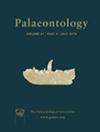棘皮动物聚类的古生物学意义:北格陵兰早寒武纪的案例研究
IF 2.3
2区 地球科学
Q1 PALEONTOLOGY
引用次数: 0
摘要
在有机壁微小化石的集合体中,簇状的棘皮藻比较常见,但这种集合体受到的关注相对较少。在这里,我们报告了北格陵兰早寒武世布恩地层中一种新的针藻群多样性。我们描述了四个属(Skiagia、Comasphaeridium、Asteridium 和 Synsphaeridium)的聚集模式及其背景种群特征(开口、内体和总体差异的存在),以便更好地了解这些棘尾虫的古生物学。尽管种内变异显著,但大多数 Skiagia 群都是单一种群,这种模式表明环境对 Skiagia 形态和聚集习性有很大影响。在范围广泛的主要是单特异性的集群中发现了大量小的(20 微米)Comasphaeridium 囊泡,这些集群很可能是在开花条件下形成的。从单属紫菀聚集体的紧密外观中可以初步推断出它们具有群居习性,而从回收的 Synsphaeridium 簇的高度保守的细胞结构中也可以清楚地证明这一点。Comasphaeridium 和 Asteridium 囊泡中缺乏外囊结构,这表明这些类群代表的是生长活跃的细胞,而不是静止的囊泡。总之,这些发现揭示了寒武纪棘皮动物细胞结构和生活方式的多样性,并说明了浮游生物在面对新的环境压力时所采取的一系列繁殖和防御策略。本文章由计算机程序翻译,如有差异,请以英文原文为准。
The palaeobiological significance of clustering in acritarchs: a case study from the early Cambrian of North Greenland
Aggregated clusters of acritarchs are relatively common among assemblages of organic‐walled microfossils, yet such associations have received relatively little attention. Here we report a new diversity of acritarch clusters from the early Cambrian Buen Formation of North Greenland. The aggregation patterns of four genera (Skiagia , Comasphaeridium , Asteridium and Synsphaeridium ) are described together with their background population characteristics (presence of openings, inner bodies and overall disparity) in order to better understand the palaeobiology of these acritarchs. The majority of Skiagia clusters were found to be monospecific despite significant intraspecific variability, a pattern that is suggestive of a strong environmental influence on Skiagia morphologies and aggregation habits. Abundant small (<20 μm) Comasphaeridium vesicles were recovered in a broad range of chiefly monospecific clusters that are likely to have been formed under bloom conditions. A colonial habit is tentatively inferred from the tightly packed appearance of monogeneric Asteridium aggregates, and clearly evidenced by the highly conserved cellular structure of recovered Synsphaeridium clusters. A lack of excystment structures in Comasphaeridium and Asteridium vesicles suggest these taxa represent actively growing cells rather than resting cysts. Altogether, these findings shed new light on the diversity of cellular structures and lifestyles represented among Cambrian acritarchs, and illustrate a range of reproduction and defence strategies adopted by plankton in the face of novel environmental pressures.
求助全文
通过发布文献求助,成功后即可免费获取论文全文。
去求助
来源期刊

Palaeontology
地学-古生物学
CiteScore
5.60
自引率
3.80%
发文量
43
审稿时长
6 months
期刊介绍:
Palaeontology publishes a wide variety of papers on palaeontological topics covering:
palaeozoology
palaeobotany
systematic studies
palaeoecology
micropalaeontology
palaeobiogeography
functional morphology
stratigraphy
taxonomy
taphonomy
palaeoenvironmental reconstruction
palaeoclimate analysis and biomineralization studies.
 求助内容:
求助内容: 应助结果提醒方式:
应助结果提醒方式:


